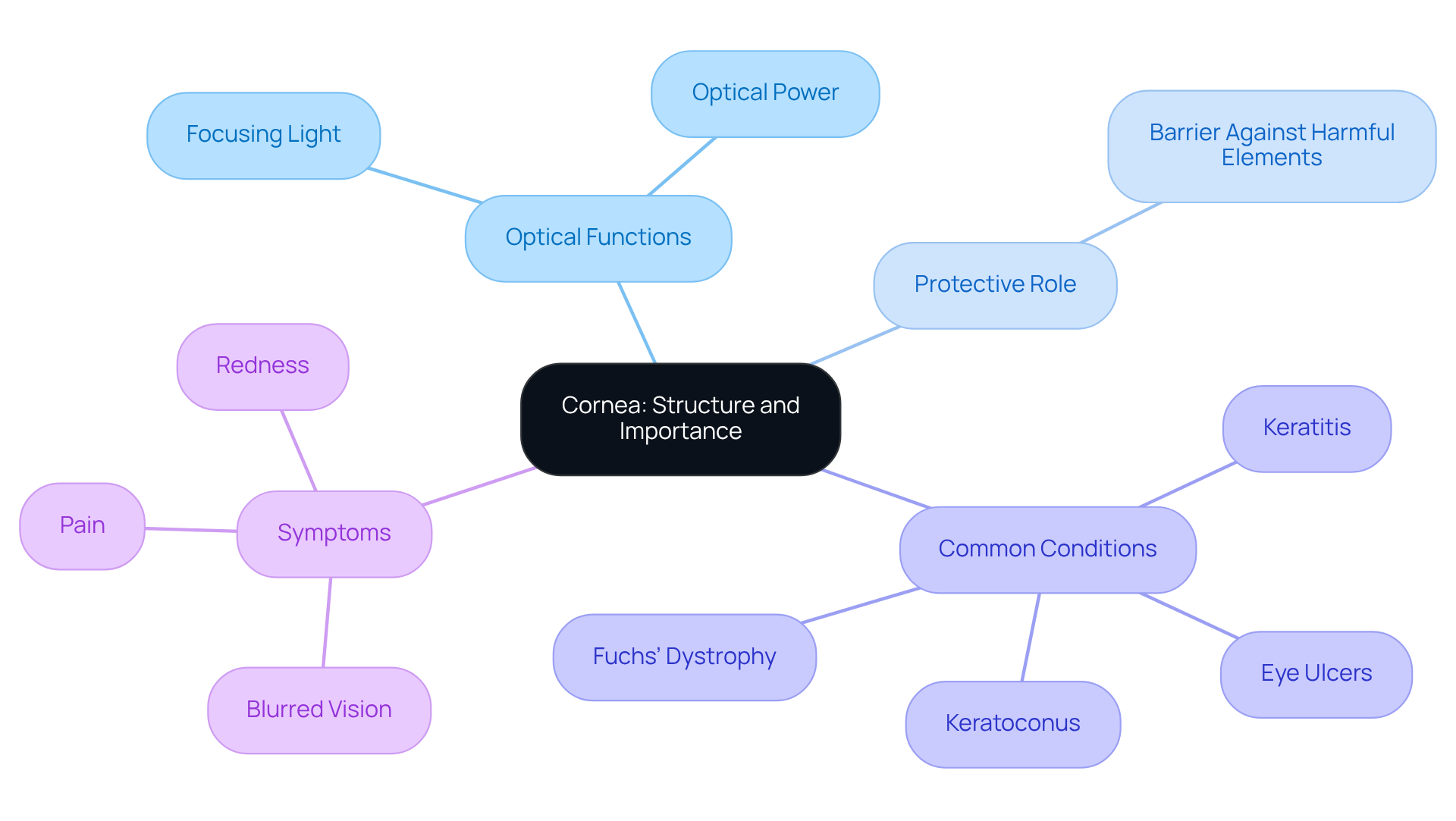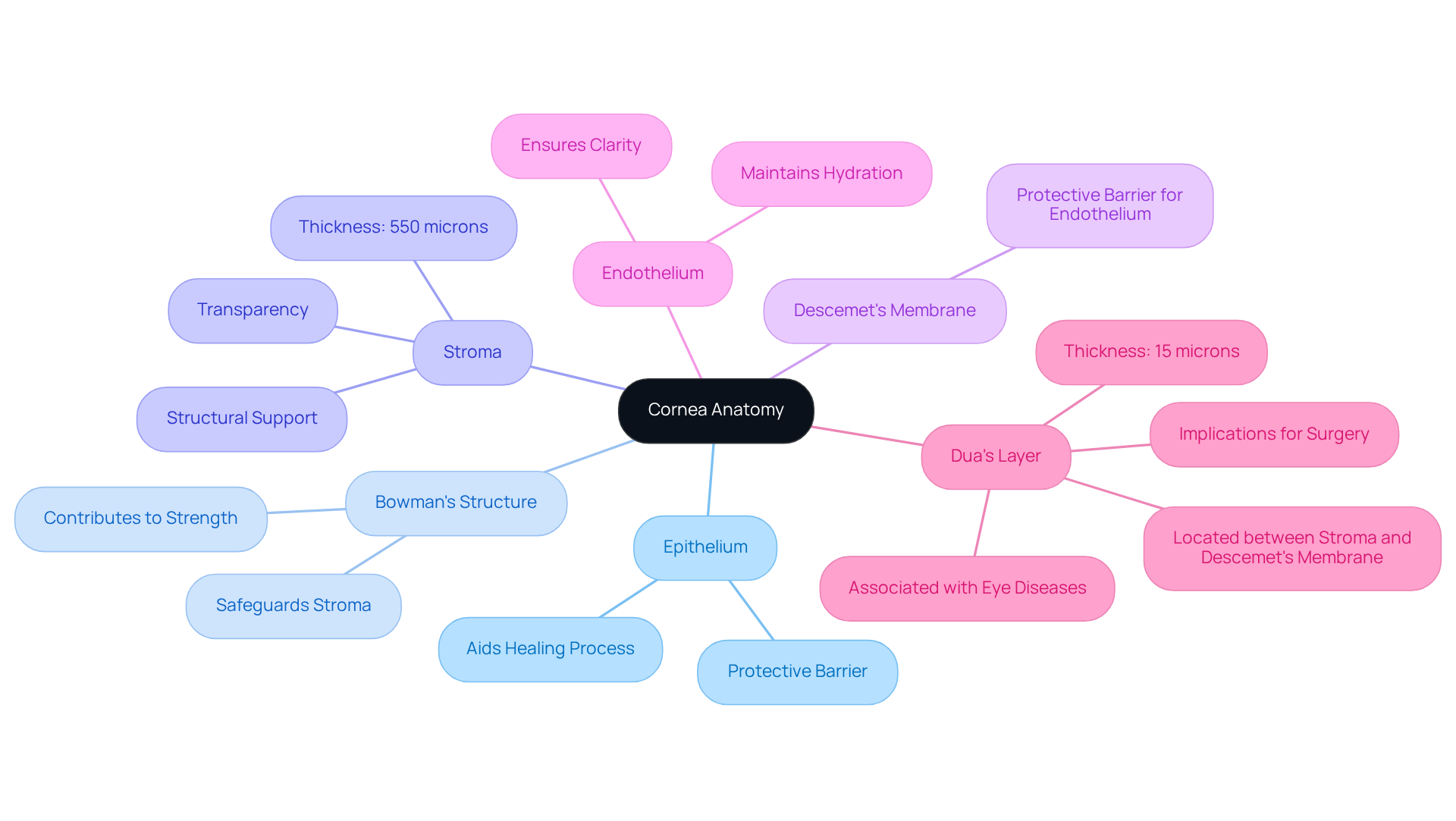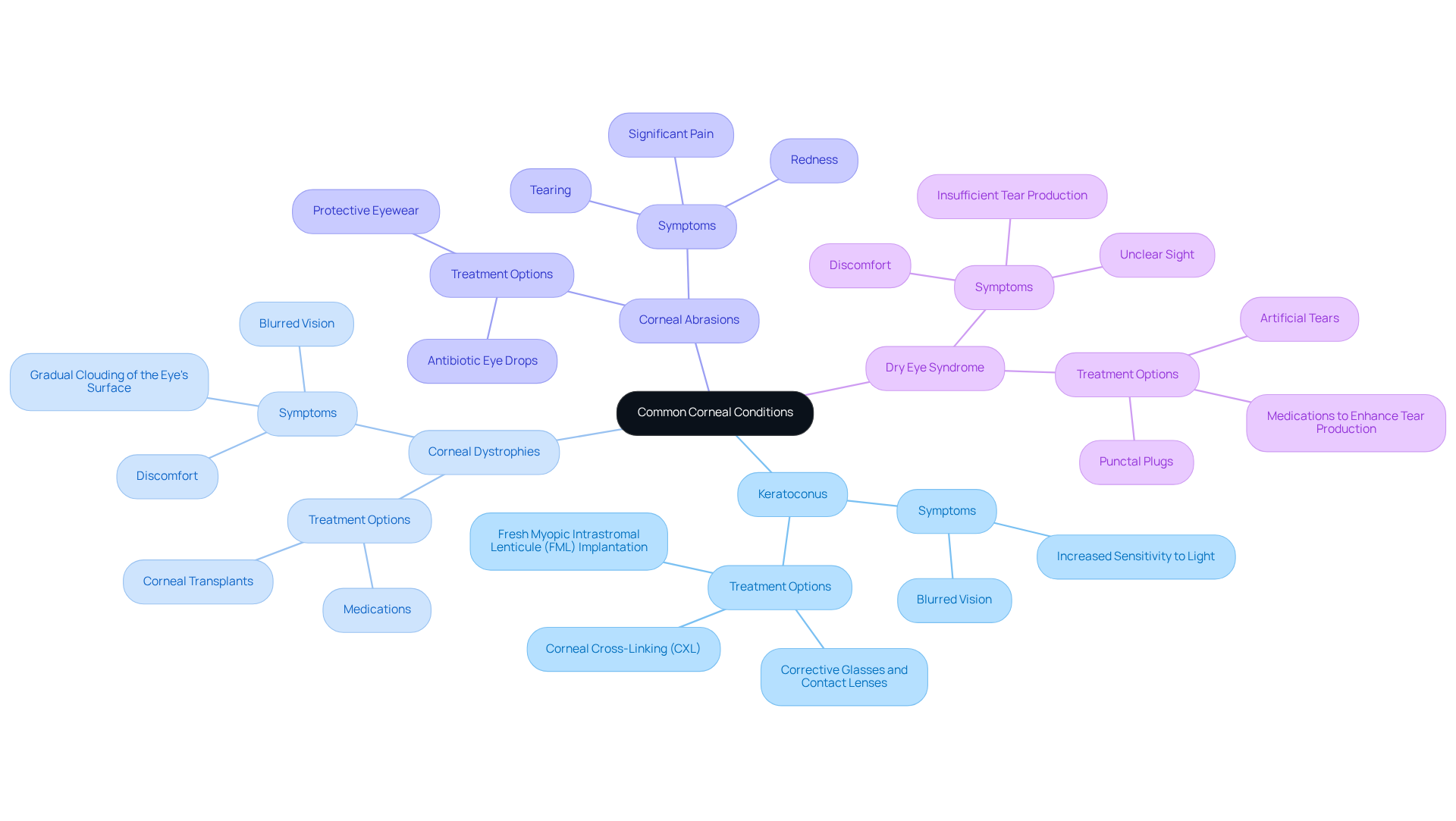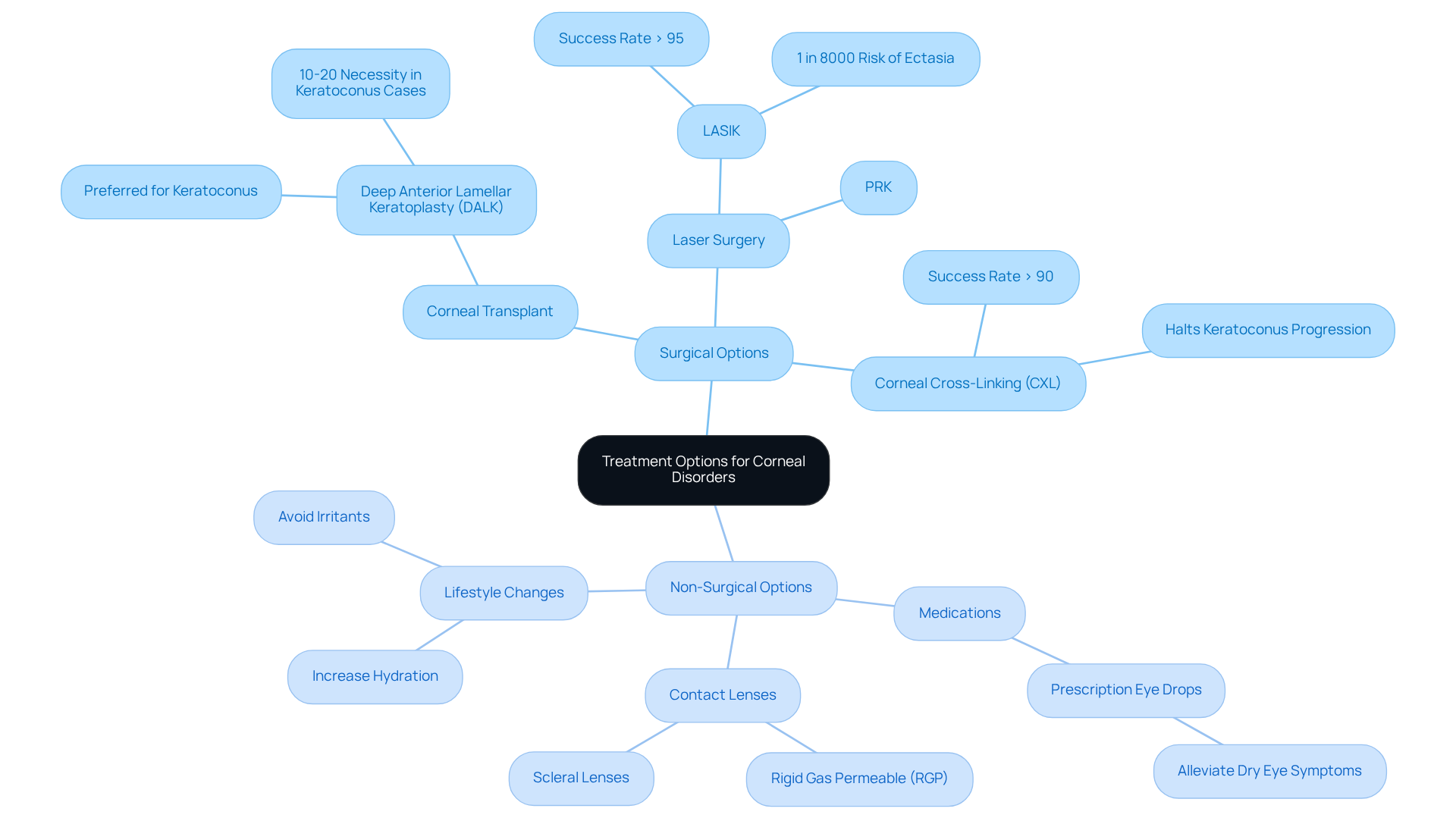Posted by: Northwest Eye in General on August 6, 2025
Overview
This article aims to help you understand the structure of the cornea, the common conditions that can affect it, and the treatments available to you. We recognize how crucial the cornea is for your vision and protection. Conditions such as keratoconus and dry eye syndrome can be concerning, but knowing about them is the first step towards taking care of your eye health.
We want to assure you that there are both surgical and non-surgical treatment options available. Early detection and proactive eye care are essential for maintaining optimal vision health. It’s common to feel overwhelmed, but remember that you are not alone in this journey. We are here to help you through this process, providing the support you need.
Taking care of your eyes is vital, and we encourage you to seek help if you notice any changes in your vision. Together, we can work towards ensuring your eye health is prioritized and protected.
Introduction
The cornea is not just a part of the eye; it serves as its first line of defense and plays a crucial role in ensuring visual clarity. It accounts for a significant portion of the eye’s optical power.
We understand that maintaining eye health and preventing vision impairment can be a source of concern for many. As corneal disorders like keratoconus and dry eye syndrome become more prevalent, navigating the complexities of diagnosis and treatment can feel overwhelming.
By exploring the anatomy of the cornea, its vital functions, and the latest therapeutic advancements, we aim to provide valuable insights for anyone seeking to safeguard their vision.
Remember, you are not alone in this journey, and we are here to help you through the process.
Explore the Cornea: Structure and Importance in Vision
The transparent front layer of the eye is essential for focusing light onto the retina, contributing approximately 65-75% of the eye’s total optical power. Its distinctive curvature and refractive characteristics are vital for achieving sharp sight. We understand that beyond its optical functions, this transparent layer also acts as a against dust, germs, and other harmful elements, highlighting its importance in maintaining overall eye health.
Grasping the cornea eye‘s complex structure not only emphasizes its crucial role in sight but also stresses the potential effects of various conditions related to the cornea on eye health. It’s common to feel concerned about frequent conditions like keratitis, eye ulcers, keratoconus, and Fuchs’ dystrophy, as these can significantly hinder sight. Awareness and early detection are essential for effective treatment.
Symptoms of these conditions may include pain, redness, and blurred vision, which should prompt you to seek medical attention. Regular examinations of the cornea eye are vital for monitoring corneal health and addressing any emerging issues promptly. Remember, we are here to help you through this process, ensuring proactive eye care.

Examine the Anatomy of the Cornea: Layers and Functions
The outermost structure of the cornea eye comprises five distinct layers: the epithelium, Bowman’s stratum, stroma, Descemet’s membrane, and endothelium. Each layer plays a vital role in maintaining the health and function of your vision:
- Epithelium: This outermost layer acts as a protective barrier against environmental damage and aids in the healing process.
- Bowman’s Structure: A resilient component that not only safeguards the stroma but also contributes to the strength of the cornea eye’s outer surface.
- Stroma: The thickest section of the cornea eye, composed of collagen fibers, provides essential structural support and transparency. The thickness of the entire human cornea eye is approximately 550 microns, underscoring the importance of these layers in preserving clear vision.
- Descemet’s Membrane: A thin sheet that serves as a protective barrier for the endothelium of the cornea eye.
- Endothelium: The innermost membrane of the cornea eye responsible for maintaining hydration and clarity.
We understand that navigating eye health can be overwhelming, especially with new findings. Recent research has revealed a new layer within the eye’s surface, known as Dua’s Layer, located between the stroma and Descemet’s membrane. This stratum, measuring about 15 microns in thickness, holds significant implications for surgical procedures and our understanding of eye diseases. Professor Harminder Dua noted, “From a medical standpoint, there are numerous ailments that impact the rear of the eye’s surface which practitioners globally are already starting to associate with the presence, absence, or rupture in this tissue.”
It’s common to feel concerned about the implications of damage to any of these layers of the cornea eye, as it can lead to conditions like keratoconus or eye dystrophies, resulting in vision impairment. Understanding the is crucial for effectively identifying and managing these conditions. Moreover, innovative therapies, such as the development of eyedrops using synthetic nanoparticles, highlight the practical applications of this knowledge in regenerating damaged ocular cells. We are here to help you through this process, ensuring that you have the support and information you need to navigate your eye health with confidence.

Identify Common Corneal Conditions: Symptoms and Treatments
Several prevalent corneal conditions can significantly impact your vision, and we understand how concerning this can be:
- Keratoconus: This progressive condition involves thinning of the cornea, which can lead to distorted vision. Many patients experience symptoms like blurred vision and increased sensitivity to light. As you age, particularly until around age 40, keratoconus can worsen. Treatment options vary widely, from corrective glasses and contact lenses to advanced procedures like cross-linking (CXL), the gold standard treatment for over 20 years. Recent studies have shown that innovative treatments, such as fresh myopic intrastromal lenticular (FML) implantation, may enhance the thickness of the eye’s surface and visual acuity, offering a less invasive alternative to traditional keratoplasty. Notably, advancements in CXL have reduced the UVA irradiation time to just 9 minutes and 15 seconds, improving comfort and outcomes for patients.
- Corneal Dystrophies: These genetic disorders can lead to gradual clouding of the eye’s surface, causing blurred vision and discomfort. Treatment options depend on the specific type of dystrophy and may include medications or corneal transplants. Understanding the genetic basis of these conditions can help in , which is crucial for your eye health.
- Corneal Abrasions: Scratches on the cornea can result in significant pain, redness, and tearing. We recommend seeking treatment promptly, which typically involves antibiotic eye drops to prevent infection and protective eyewear to facilitate healing. Addressing abrasions quickly is essential to avoid complications.
- Dry Eye Syndrome: Characterized by insufficient tear production, this condition can lead to discomfort and unclear sight. Treatment strategies may include artificial tears, medications to enhance tear production, or punctal plugs to retain moisture. It’s important to note that dry eye disease affects a substantial portion of the population, with prevalence rates ranging from 5 to 50 percent globally.
Recognizing these conditions and their associated symptoms is crucial for timely intervention and effective management, ensuring optimal eye health. We are here to help you through this process. For further information, you can access resources like the Eye Condition Library provided by Northwest Eye, which empowers you to better understand your conditions.

Understand Treatment Options for Corneal Disorders: From Surgery to Care
When facing , it’s important to understand that treatment options are customized based on your specific condition and its severity. We understand that this can be a challenging time, and we are here to help you navigate through it with both surgical and non-surgical approaches available.
-
Surgical Options:
- Corneal Transplant: For those experiencing severe corneal damage or disease, a corneal transplant may be essential to restore vision. Methods like Deep Anterior Lamellar Keratoplasty (DALK) are often preferred for conditions like keratoconus that affect the cornea eye. This technique helps maintain the healthy inner layer of the eye’s surface, which lowers the risk of rejection and enhances long-term results. In fact, cornea eye transplants become necessary in 10-20% of keratoconus cases when non-surgical options do not suffice.
- Laser Surgery: Procedures like LASIK and PRK are effective in correcting refractive errors by reshaping the cornea eye. With a success rate exceeding 95%, LASIK has truly transformed the vision correction landscape, allowing many patients to achieve 20/20 vision or better. It’s common to feel concerned about risks; however, the occurrence of eye ectasia after LASIK is approximately 1 in 8000, which underscores the importance of thorough patient selection.
- Corneal Cross-Linking (CXL): This innovative treatment strengthens the cornea eye tissue to halt the progression of keratoconus. CXL boasts a success rate of over 90% in stopping disease progression and is especially beneficial for younger patients, helping them maintain sight and avoid more invasive procedures.
-
Non-Surgical Options:
- Medications: Prescription eye drops can alleviate symptoms of dry eye or inflammation, providing relief and improving comfort for patients.
- Contact Lenses: Specialized lenses, including Rigid Gas Permeable (RGP) and scleral lenses, are designed to enhance vision in individuals with irregular corneas, offering significant improvements in clarity and comfort.
- Lifestyle Changes: Simple recommendations, such as increasing hydration and avoiding irritants, can help you manage symptoms effectively.
By understanding these treatment options, you can actively engage in your care. We encourage you to make informed decisions that align with your individual eye health needs, knowing that support is always available to guide you through this journey.

Conclusion
The cornea is essential for vision, acting as the eye’s transparent front layer that focuses light onto the retina while also serving as a protective barrier against harmful elements. Understanding its structure and functions is crucial, not only for appreciating how it contributes to clear sight but also for recognizing the potential impact of various corneal conditions on overall eye health.
Throughout this article, we’ve explored the anatomy of the cornea, highlighting its five distinct layers, each playing a unique role in maintaining eye health. Conditions such as keratoconus, corneal dystrophies, and dry eye syndrome remind us of the importance of awareness and early detection. It’s common to feel concerned about these issues, but timely intervention can significantly enhance treatment outcomes.
Additionally, we’ve discussed both surgical and non-surgical treatment options, emphasizing the necessity of personalized care in effectively managing corneal disorders. We understand that navigating these choices can be overwhelming, but recognizing the significance of the cornea in eye health empowers you to take proactive steps in your vision care.
By staying informed about corneal conditions and available treatments, you can better advocate for your eye health and seek timely medical advice. Embracing this knowledge not only enhances your personal well-being but also fosters a broader understanding of the intricate relationship between the cornea and overall vision health. Remember, we are here to help you through this process, ensuring you feel supported every step of the way.
Frequently Asked Questions
What is the cornea and what role does it play in vision?
The cornea is the transparent front layer of the eye that is essential for focusing light onto the retina, contributing approximately 65-75% of the eye’s total optical power.
How does the structure of the cornea affect vision?
The distinctive curvature and refractive characteristics of the cornea are vital for achieving sharp sight.
Besides its optical functions, what other role does the cornea serve?
The cornea acts as a protective barrier against dust, germs, and other harmful elements, which is important for maintaining overall eye health.
What are some common conditions that can affect the cornea?
Common conditions include keratitis, eye ulcers, keratoconus, and Fuchs’ dystrophy, which can significantly hinder sight.
What symptoms should prompt a visit to a medical professional regarding corneal health?
Symptoms such as pain, redness, and blurred vision should prompt you to seek medical attention.
Why are regular examinations of the cornea important?
Regular examinations are vital for monitoring corneal health and addressing any emerging issues promptly.
How can awareness and early detection impact corneal conditions?
Awareness and early detection are essential for effective treatment of corneal conditions, helping to prevent further complications.






